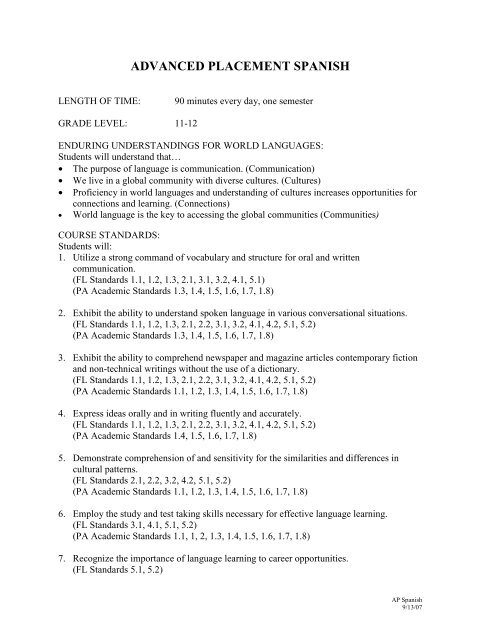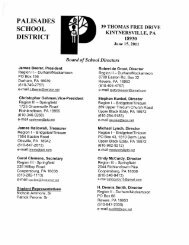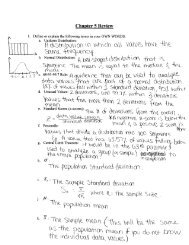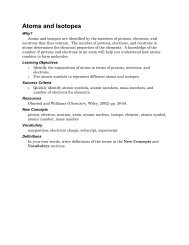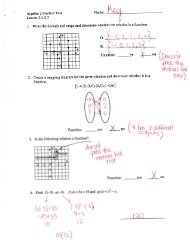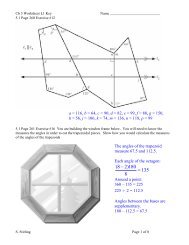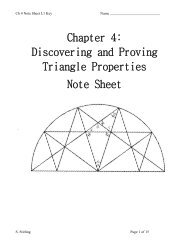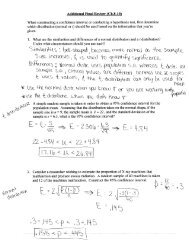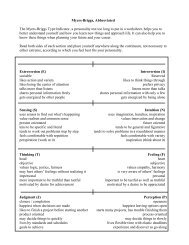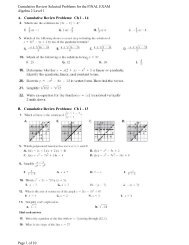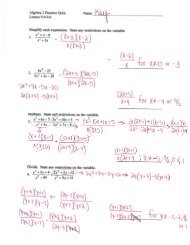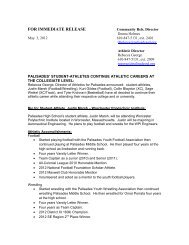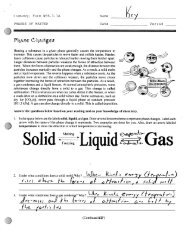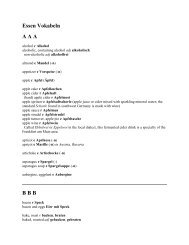AP Spanish - revised 091307
AP Spanish - revised 091307
AP Spanish - revised 091307
Create successful ePaper yourself
Turn your PDF publications into a flip-book with our unique Google optimized e-Paper software.
ADVANCED PLACEMENT SPANISH<br />
LENGTH OF TIME:<br />
90 minutes every day, one semester<br />
GRADE LEVEL: 11-12<br />
ENDURING UNDERSTANDINGS FOR WORLD LANGUAGES:<br />
Students will understand that…<br />
• The purpose of language is communication. (Communication)<br />
• We live in a global community with diverse cultures. (Cultures)<br />
• Proficiency in world languages and understanding of cultures increases opportunities for<br />
connections and learning. (Connections)<br />
• World language is the key to accessing the global communities (Communities)<br />
COURSE STANDARDS:<br />
Students will:<br />
1. Utilize a strong command of vocabulary and structure for oral and written<br />
communication.<br />
(FL Standards 1.1, 1.2, 1.3, 2.1, 3.1, 3.2, 4.1, 5.1)<br />
(PA Academic Standards 1.3, 1.4, 1.5, 1.6, 1.7, 1.8)<br />
2. Exhibit the ability to understand spoken language in various conversational situations.<br />
(FL Standards 1.1, 1.2, 1.3, 2.1, 2.2, 3.1, 3.2, 4.1, 4.2, 5.1, 5.2)<br />
(PA Academic Standards 1.3, 1.4, 1.5, 1.6, 1.7, 1.8)<br />
3. Exhibit the ability to comprehend newspaper and magazine articles contemporary fiction<br />
and non-technical writings without the use of a dictionary.<br />
(FL Standards 1.1, 1.2, 1.3, 2.1, 2.2, 3.1, 3.2, 4.1, 4.2, 5.1, 5.2)<br />
(PA Academic Standards 1.1, 1.2, 1.3, 1.4, 1.5, 1.6, 1.7, 1.8)<br />
4. Express ideas orally and in writing fluently and accurately.<br />
(FL Standards 1.1, 1.2, 1.3, 2.1, 2.2, 3.1, 3.2, 4.1, 4.2, 5.1, 5.2)<br />
(PA Academic Standards 1.4, 1.5, 1.6, 1.7, 1.8)<br />
5. Demonstrate comprehension of and sensitivity for the similarities and differences in<br />
cultural patterns.<br />
(FL Standards 2.1, 2.2, 3.2, 4.2, 5.1, 5.2)<br />
(PA Academic Standards 1.1, 1.2, 1.3, 1.4, 1.5, 1.6, 1.7, 1.8)<br />
6. Employ the study and test taking skills necessary for effective language learning.<br />
(FL Standards 3.1, 4.1, 5.1, 5.2)<br />
(PA Academic Standards 1.1, 1, 2, 1.3, 1.4, 1.5, 1.6, 1.7, 1.8)<br />
7. Recognize the importance of language learning to career opportunities.<br />
(FL Standards 5.1, 5.2)<br />
<strong>AP</strong> <strong>Spanish</strong><br />
9/13/07
(PA Academic Standards 1.1, 1, 2, 1.8)<br />
8. Utilize technology as a resource tool, reinforcement/enrichment tool, and for production<br />
of oral and written work.<br />
(FL Standards 3.1, 5.1, 5.2)<br />
(PA Academic Standards 1.8)<br />
RELATED PA ACADEMIC STANDARDS FOR READING, WRITING, SPEAKING<br />
AND LISTENING<br />
1.1 Learning to Read Independently<br />
1.2 Reading Critically in All Content Areas<br />
1.3 Reading, Analyzing and Interpreting Literature<br />
1.4 Types of Writing<br />
1.5 Quality of Writing<br />
1.6 Speaking and Listening<br />
1.7 Characteristics and Function of the English Language<br />
1.8 Research<br />
WORLD LANGUAGE STANDARDS: ACTFL<br />
Communication 1.1, 1.2, 1.3<br />
Cultures 2.1, 2.2<br />
Connections 3.1, 3.2<br />
Comparisons 4.1, 4.2<br />
Communities 5.1 5.2<br />
PERFORMANCE ASSESSMENTS (Integrated throughout):<br />
The Advanced Placement <strong>Spanish</strong> Language Examination is not based on specific content<br />
but instead attempts to evaluate levels of performance in the use of the language, both in<br />
understanding written and spoken <strong>Spanish</strong> an in writing and speaking with ease in correct<br />
and idiomatic <strong>Spanish</strong>. The examination consists of two sections. Section I, a multiplechoice<br />
section, tests listening and reading comprehension. Section II, a free-response section,<br />
tests the productive skills of speaking and writing. The portion of the examination devoted to<br />
each skill contributes toward the final <strong>AP</strong> grade as follows: Listening 20 percent, Reading 30<br />
percent, Writing 30 percent, and Speaking 20 percent. This allocation corresponds to<br />
colleges’ emphasis on reading and writing in their advanced courses.<br />
Students will demonstrate achievement of the standards by:<br />
1. Utilizing in the target language a broad range of vocabulary and advanced structures by<br />
incorporating them fluently and accurately in extended oral and written communication<br />
to narrate, describe, and explain in a variety of time frames/moods in response to oral and<br />
written prompts. (Course Standards 1,4,6,8)<br />
2. Constructing a fluent, logical, and culturally appropriate situational response, answering<br />
questions, and summarizing salient points to demonstrate understanding of spoken<br />
language in various conversational and presentational situations on a variety of topics.<br />
(Course Standards 1,2,4,5,6,8)<br />
<strong>AP</strong> <strong>Spanish</strong><br />
9/13/07
3. Sustaining face-to-face conversation by participating in discussions, interviews, and<br />
situational role-plays. (Course Standards 1,2,4,5,6,8)<br />
4. Identifying main ideas and supporting details on a variety of topics without the use of a<br />
dictionary using prior knowledge, deduction, and inference to answer questions,<br />
summarize and respond to a variety of genres (newspaper and magazine articles, literary<br />
texts, and non-technical writings) and styles of both written and spoken messages.<br />
(Course Standards 1, 2, 3, 4, 5, 6, 8)<br />
.<br />
DESCRIPTION OF COURSE:<br />
In <strong>AP</strong> <strong>Spanish</strong>, the objective is to develop and refine the skills that have been acquired in the<br />
four previous levels. Emphasis is placed on vocabulary development, the comprehension of<br />
spoken and written language, the accurate expression of ideas in speaking, writing and<br />
cultural awareness. Functional language proficiency in listening, speaking, reading, and<br />
writing on an intermediate college level is the course goal.<br />
Reading of Claims and Evidences (from the <strong>AP</strong> Central and <strong>AP</strong> <strong>Spanish</strong> Language Exam<br />
Web sites) is an explanation of what the students are expected to know and be able to do on<br />
the Exam, and how these skills will be evaluated and weighed. During the first two weeks<br />
opportunity to refresh and review their skills is provided, however after 2 weeks the class is<br />
conducted in <strong>Spanish</strong>. Some of the more complicated, compound-complex structures<br />
(imperfecto del subjuntivo) may require some clarification in English. Grades reflect the use<br />
of <strong>Spanish</strong> in the class.<br />
The students are required to complete extensive work during the summer prior to the start of<br />
the course. The assignments include short story readings, recording of new vocabulary in<br />
their vocabulary journals, grammar review exercises, <strong>Spanish</strong> television, news web sites and<br />
podcasts to report on current events and a personal journal with at least three entries per<br />
week, detailing vacations, day trips, job experiences, etc. Each day of the first week is<br />
dedicated to familiarizing the students with the sections and items on the Exam and a review<br />
of verb tenses. Students are required to purchase a bilingual dictionary and a micro cassette<br />
recorder used with Informal Speaking Simulated Conversation and the Formal Oral<br />
Presentation, which are graded.<br />
No skill is practiced in isolation. A typical week’s activities will blend all four skills, reading,<br />
writing, listening and speaking. Every Tuesday and Thursday students will rotate presenting<br />
an oral summary of a topic which they have gotten from the Internet and distribute the<br />
document to the class. Themes include global warming, the new Secretary General of the<br />
UN, the founding of the OAS, the background of the EU and different aspects of US<br />
Immigration Policy, especially as it relates to Mexico, Central and South America. The<br />
students skim the article and as a group generate discussion questions and add key words to<br />
their vocabulary journals. The expectation is that this rich, sophisticated vocabulary will be<br />
incorporated into their formal writing and oral tasks. On Monday and Wednesday short news<br />
clips from Univisión are used for authentic input, thematic vocabulary, writing and speaking.<br />
<strong>AP</strong> <strong>Spanish</strong><br />
9/13/07
Students take notes on the broadcast and discuss and comment on the main theme and<br />
supporting details. Key vocabulary is recorded into their vocabulary journals.<br />
Every week a reading selection from Abriendo Paso Lectura is assigned. This text has the<br />
multiple choice comprehension questions with the same format as the <strong>AP</strong> Exam and the<br />
listening selection which accompanies each story compliments the topic of the short story or<br />
article. Students listen to the CD twice, however as we get closer to the Exam date they may<br />
only hear the selection once to simulate test conditions. This format is followed for the<br />
Informal and Formal Oral Practice also. The textbook also has excellent vocabulary<br />
enrichment activities to develop word family connections and synonyms. Every short story is<br />
assessed through summary paragraph writing and the related listening selection. Every other<br />
week students will be required to write a 200 word essay following the Formal Writing<br />
format.<br />
COURSE GOALS:<br />
In this course students will:<br />
• Expand their interpersonal communication skills in <strong>Spanish</strong> through daily classroom<br />
interactions in the language. This includes casual conversations and formal discussions<br />
with the teacher and fellow classmates.<br />
• Increase and refine their written, oral and comprehension skills in both formal and<br />
informal contexts thus gaining confidence to express ideas with accuracy and fluency.<br />
• Acquire meaningful vocabulary used in authentic language<br />
• Make connections between their learning in the <strong>Spanish</strong> classroom and their daily lives.<br />
• Broaden their understanding and appreciation of <strong>Spanish</strong> speaking cultures, history and<br />
current events.<br />
• Familiarize themselves with the format and the content of the <strong>AP</strong> <strong>Spanish</strong> Language<br />
Exam.<br />
TITLES OF UNITS:<br />
ABRIENDO PASO – textbook<br />
Chapter I El décimo by Emilia Pardo Bazán<br />
• Word Families<br />
• Realism Style<br />
• Narrative/Descriptive Writing<br />
Chapter 2 Ríete con ellos, no de ellos by Julia Viñas<br />
• Irony and Sarcasm<br />
• Persuasive Writing<br />
• Word families<br />
Chapter 3 Nosotros, No by José Bernardo Adolph<br />
• Word families<br />
• Stereotypes<br />
• Descriptive/Persuasive Writing<br />
<strong>AP</strong> <strong>Spanish</strong><br />
9/13/07
Chapter 4 Me llamo Rigoberta Menchú by Rigoberta Menchú<br />
• Autobiography/Historical Essay<br />
• Word families/Synonyms<br />
• Letter Writing<br />
Chapter 5 Jacinto Contreras by Camilo José Cela<br />
• Word families<br />
• Realism style/Pessimism, loneliness and anguish<br />
• Narrative/Descriptive writing<br />
Chapter 6 Baby H.P. by Juan José Arreola<br />
• Word families<br />
• Irony/Persuasive writing<br />
• Comparing/Distinguishing<br />
Chapter 7 El árbol de oro by Ana María Matute<br />
• Word families<br />
• Describing the past/Sequencing events<br />
• Fantasy writing<br />
MODERN SPANISH PROSE - textbook<br />
Chapter I El limpiabotas by Pedro Epinoza Bravo<br />
• Modern short story techniques /Mystery<br />
• Word families/synonyms<br />
Chapter 2 El arrepentido by Ana Maria Matute<br />
• Realism style/Death, grief, and loneliness<br />
• Comparisons/ More, less<br />
Chapter 3 Una carta a Dios by Gregorio López y Fuentes<br />
• Humor and irony<br />
• The neuter article “lo”<br />
<strong>AP</strong> TEST PREPARATION (throughout the course)<br />
• Authentic listening activities<br />
• Grammar<br />
• Reading comprehension<br />
• Close exercises<br />
• Compositions (Formal/Informal Writing)<br />
• Formal/Informal Oral Presentation<br />
INDEPENDENT/GROUP PROJECT (post <strong>AP</strong> test)<br />
<strong>AP</strong> <strong>Spanish</strong><br />
9/13/07
The remaining time after the <strong>AP</strong> Exam is devoted to a final project on <strong>Spanish</strong> and Latin<br />
American artists. The choices are:<br />
Golden Age 20 th Century Latin America<br />
El Greco Picasso Diego Rivera<br />
Velázquez Joan Miró David Siqueiros<br />
Goya Dalí Rufino Tamayo<br />
Juan Gris<br />
Gaudí<br />
Frida Kahlo<br />
Wilfredo Lam<br />
Fernando Botero<br />
With teacher approval another artist may be selected. The students view videos from my<br />
personal collection on each of the artists and peruse the many art catalogues I have collected<br />
from El Prado, La Reina Sofía, the Metropolitan in NYC and the Philadelphia Art Museum<br />
and museums from my trips to México, Costa Rica and Perú. Using approved web sites for<br />
downloading copies of paintings, the students will select one of the artists and produce a<br />
power point presentation to show to the class.<br />
The presentation must include:<br />
• An extensive selection of paintings to accompany the script<br />
• A biographical outline of the artist<br />
• Personal experiences that impacted his/her art<br />
• Historical events that influenced his/her art<br />
• The artistic evolution of the artist<br />
• The artistic innovations of the artist<br />
• The student’s favorite painting (why?)<br />
• The student’s personal reflection (why did he/she select this artist and how was he/she<br />
affected by his/her art.<br />
• This project is written and presented in <strong>Spanish</strong> and is worth 100 points.<br />
SAMPLE INSTRUCTIONAL STRATEGIES:<br />
1. Differentiated Instruction via Process, Product, Content and Environment<br />
2. Cooperative learning groups<br />
3. Small group activities<br />
4. Extended listening utilizing audio and video segments<br />
5. Discussions/analysis of readings (variety of genres)<br />
6. Summaries<br />
7. Compositions (Formal/Informal Writing)<br />
8. Formal/Informal Oral Presentation<br />
9. <strong>AP</strong> test taking skills development/practice<br />
10. Research producing multimedia presentations<br />
MATERIALS:<br />
1. Abriendo Paso Lectura, José M. Díaz, María F. Nadel and Stephen Collins, Prentice<br />
Hall, 2000<br />
<strong>AP</strong> <strong>Spanish</strong><br />
9/13/07
2. Abriendo Paso Gramática, José M. Díaz, María F. Nadel and Stephen Collins, Prentice<br />
Hall, 2000<br />
3. <strong>AP</strong> <strong>Spanish</strong>, Preparing for the Language Examination, José M. Díaz, Margarita<br />
Leicher-Prieto, and Gilda Nissenberg, Prentice Hall, 2006, Third Edition<br />
4. Modern <strong>Spanish</strong> Prose, Gustave W. Andrian, Prentice Hall, 2000<br />
5. Puerta del Sol, The <strong>Spanish</strong> Language Audio Magazine, Champs-Elysées, Inc. 2007.<br />
6. Diccionario de sinónimos y antónimos, Aaron Alboukrek and Gloria Fuentes,<br />
Larousse.<br />
7. Conversation in <strong>Spanish</strong>, Points of Departure, Frank Sedwick, Heinle & Heinle, Fifth<br />
Edition, 1989<br />
8. A Comprehensive Guide to the Subjunctive in <strong>Spanish</strong> by Livia Kampe, 1992.<br />
9. Pasajes Cultura, Bretz, Dvorak, Kirschner, 6 th Edition, McGraw Hill, 2006<br />
10. El Nuevo Herald <strong>Spanish</strong> language newspaper<br />
11. Advanced placement <strong>Spanish</strong> practice test, ETS<br />
12. Audio tapes/ video tapes to accompany texts<br />
13. Supplemental videos and slides<br />
14. Computer software<br />
15. Internet primary sources<br />
16. Miscellaneous realia<br />
17. Magazines<br />
18. Supplemental materials (texts, maps, etc.)<br />
19. Teacher made materials<br />
20. Web Sites: <strong>AP</strong> Central Website, Univisión.com, BBC Mundo.com, RadioNaciones<br />
Unidas.org/radio/es, CNN en español, El País.com, Think <strong>Spanish</strong>.com, Study<br />
<strong>Spanish</strong>.com, El Nuevo Herald.com, Wikipedia.org.<br />
<strong>AP</strong> <strong>Spanish</strong><br />
9/13/07
METHODS OF ASSISTANCE AND ENRICHMENT:<br />
1. Retest as appropriate<br />
2. Academic tutorial<br />
3. Differentiated Instruction via Process, Product, Content and Environment<br />
4. Field trips – Latin America and Spain (alternating years)<br />
5. Interdisciplinary units/independent reading<br />
6. Peer tutoring<br />
7. Technical enrichment<br />
PORTFOLIO DEVELOPMENT:<br />
1. Presentation rubric<br />
2. Research paper and oral presentation (<strong>Spanish</strong>/Latin American artist)<br />
3. Compositions<br />
4. Recorded Oral Proficiencies<br />
METHODS OF EVALUATION:<br />
1. Preassessment to determine differentiation<br />
2. Tests/summaries<br />
3. Quizzes/listening tapes<br />
4. Compositions<br />
5. Oral proficiency presentations<br />
6. Final project<br />
7. Class work<br />
8. Participation<br />
9. Homework<br />
INTEGRATED ACTIVITIES:<br />
1. Concepts<br />
• -Verb conjugations/tenses<br />
• -Vocabulary<br />
• -Expressing /analyzing opinions<br />
• -Culture of the target language<br />
2. Communication (spoken or written form)<br />
• -dialogs, monologs, interviews, summaries, compositions<br />
• -questions and extended responses<br />
• -use of thematic vocabulary<br />
3. Thinking/Problem Solving<br />
• -circumlocution of language<br />
• -brainstorming keywords<br />
• -classification/recognition of ideas into main and supporting details<br />
• -original recombination of materials in sentences and paragraphs<br />
• -use of appropriate sentence and paragraph structure according to the situation<br />
(questions/responses/statements/negatives/verb tense)<br />
<strong>AP</strong> <strong>Spanish</strong><br />
9/13/07
4. Application of Knowledge<br />
• -use of information to create dialogs, monologues, and compositions<br />
• -subject/verb/tense agreement in complex and compound sentences<br />
• -completion of assigned oral proficiency activities/assessments<br />
• -use of information to comprehend extended passages<br />
5. Interpersonal Skills<br />
• -cooperative paired/group activities<br />
• -sensitivity to cultural differences<br />
<strong>AP</strong> <strong>Spanish</strong><br />
9/13/07


